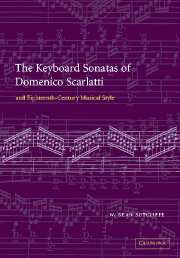6 - ‘Una genuina música de tecla’
Published online by Cambridge University Press: 22 September 2009
Summary
FINGERMUSIK AND ‘MERE VIRTUOSITY’
To play or to compose? The star turn in the Sonata in A major, K. 65 (Ex. 6.1), the passage beginning in bar 3, is no sort of theme or recognizable piece of invention but owes its genesis to the sheer joy of playing. It corresponds to a common strain in the literature according to which Scarlatti thought through his fingers, and his inspiration came through the symbiosis of hands and keyboard (hence Roberto Pagano's term ‘Fingermusik’). What we have here is, if not a ‘finger motive’, then a ‘hand motive’. Commentators tend to assume, though, that the matter is as simple as that, that physical invention takes over to the exclusion of more obviously considered methods of creating music (as we saw with the rationale of improvisation introduced in Chapter 2). This admirably emphasizes the physical immediacy of much of the composer's music, which is after all one of its most novel and revolutionary attributes, but the idea that Scarlatti was a slave to his fingers ultimately wears a bit thin. A work like K. 65 makes clear that he was well aware that the legitimacy of such an approach is open to question. Digital freedom is not a given here but is subject to a process of argumentation; it is one element that must fight against others to assert its right to exist.
- Type
- Chapter
- Information
- Publisher: Cambridge University PressPrint publication year: 2003

